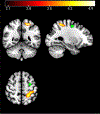Task-dependent functional connectivity of pain is associated with the magnitude of placebo analgesia in pain-free individuals
- PMID: 37344957
- PMCID: PMC10527332
- DOI: 10.1002/ejp.2145
Task-dependent functional connectivity of pain is associated with the magnitude of placebo analgesia in pain-free individuals
Abstract
Background: Task-based functional connectivity (FC) of pain-related regions resulting from expectancy-based placebo induction has yet to be examined, limiting our understanding of regions and networks associated with placebo analgesia.
Methods: Fifty-five healthy pain-free adults over 18 (M = 22.8 years, SD = 7.75) were recruited (65.5% women; 63.6% non-Hispanic/Latino/a/x; 58.2% White). Participants completed a baseline followed by a placebo session involving the topical application of an inactive cream in the context of an expectancy-enhancing instruction set. Noxious heat stimuli were applied to the thenar eminence of the right palm using an fMRI-safe thermode. Stimulus intensity was individually calibrated to produce pain ratings of approximately 40 on a 100-point visual analogue scale.
Results: A total of 67.3% of the participants showed a reduction in pain intensity in the placebo condition with an average reduction in pain across the whole sample of 12.7%. Expected pain intensity was associated with reported pain intensity in the placebo session (b = 0.32, p = 0.004, R2 = 0.15). Voxel-wise analyses indicated seven clusters with significant activation during noxious heat stimulation at baseline (pFDR < 0.05). Generalized psychophysiological interaction analysis suggested that placebo-related FC changes between middle frontal gyrus-superior parietal lobule during noxious stimulation were significantly associated with the magnitude of pain reduction (pFDR < 0.05).
Conclusions: Results suggest that stronger expectancy-based placebo responses might be underpinned by greater FC among attentional and somatosensory regions.
Significance: This article provides support and insight for task-dependent functional connectivity differences related to the magnitude of placebo analgesia. Our findings provide key support that the magnitude of expectation-based placebo response depends on the coupling of regions associated with somatosensory and attentional processing.
© 2023 European Pain Federation - EFIC ®.
Conflict of interest statement
Figures





Similar articles
-
The Two Sides of Placebo Analgesia: Differential Functional Connectivity Reveals Mechanisms of Placebo Analgesic Response.J Pain Res. 2025 Jan 10;18:189-201. doi: 10.2147/JPR.S483157. eCollection 2025. J Pain Res. 2025. PMID: 39816204 Free PMC article.
-
Neural bases of conditioned placebo analgesia.Pain. 2010 Dec;151(3):816-824. doi: 10.1016/j.pain.2010.09.021. Epub 2010 Oct 12. Pain. 2010. PMID: 20943318
-
Placebo analgesia enhances descending pain-related effective connectivity: a dynamic causal modeling study of endogenous pain modulation.J Pain. 2015 Aug;16(8):760-8. doi: 10.1016/j.jpain.2015.05.001. Epub 2015 May 27. J Pain. 2015. PMID: 26022539 Free PMC article.
-
Functional imaging of brain responses to pain. A review and meta-analysis (2000).Neurophysiol Clin. 2000 Oct;30(5):263-88. doi: 10.1016/s0987-7053(00)00227-6. Neurophysiol Clin. 2000. PMID: 11126640 Review.
-
Placebo analgesia: findings from brain imaging studies and emerging hypotheses.Rev Neurosci. 2007;18(3-4):173-90. doi: 10.1515/revneuro.2007.18.3-4.173. Rev Neurosci. 2007. PMID: 18019605 Review.
Cited by
-
The Two Sides of Placebo Analgesia: Differential Functional Connectivity Reveals Mechanisms of Placebo Analgesic Response.J Pain Res. 2025 Jan 10;18:189-201. doi: 10.2147/JPR.S483157. eCollection 2025. J Pain Res. 2025. PMID: 39816204 Free PMC article.
-
Generalisation of Placebo and Nocebo Effects: Current Knowledge and Future Directions.Eur J Pain. 2025 Jul;29(6):e70018. doi: 10.1002/ejp.70018. Eur J Pain. 2025. PMID: 40342187 Free PMC article. Review.
References
Publication types
MeSH terms
Grants and funding
LinkOut - more resources
Full Text Sources
Medical

